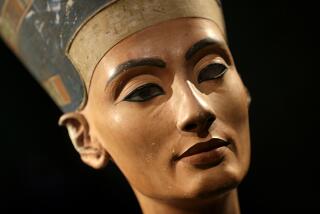Risk for the Sake of Beauty : Eyebrow and eyelash dyes are popular with women who want the natural look. But the FDA says beware.
- Share via
Thinking of going without makeup this summer, but retaining a mild makeup look by having your eyelashes and eyebrows professionally tinted?
Think again.
Because of the risk involved, eyelash and eyebrow tints are not approved by the federal government, says John Bailey, a physician and director of the Food and Drug Administration’s Office of Cosmetics and Colors. “The products are all illegal, and they pose a certain risk of serious injury to the eyes, temporary blindness and eye irritation,” he says.
The dyes that salons use are imported illegally from Europe, Bailey says. Because the dye comes in small packages, it can be brought into the country because it is hard to spot in suitcases, he explains.
The process, popular with women with light-colored lashes, takes about 25 minutes and lasts four weeks, says Deb E Coffield, a skin-care specialist at Eli Dafesh, a Woodland Hills salon. The process generally costs about $15.
But most salon patrons who seek respite from sticky, sometimes drippy, mascara do not even ask if the dyes used are safe or FDA-approved, says Rima Shahverdi, an aesthetician at Papillons in Studio City.
“Most people want to know how long it will last, but only a few ask if it’s safe,” she says.
The issue of safe lash tinting is not new. The first law to mandate safety tests for cosmetics--the 1938 Food, Drug and Cosmetics Act--was spurred by a legal case involving injuries caused by a coal tar-based lash dye. Most imported dyes used today are petroleum based and do not contain coal tar, Bailey says.
But the risks lash dyes pose are still serious. Eye tissue, which is soft and sensitive, can react to dye ingredients and develop swelling, inflammation and other problems, Bailey says. While severe incidents are rare--only about two cases of temporary blindness caused by lash tinting are reported to the FDA every year--experts estimate that many thousands of cases of severe irritation and inflammation are never reported.
John Wallace, a food and drug scientist with the state Department of Health Services, says about 18% of the adverse reactions to cosmetics that are reported to the FDA are eye-related. The FDA has recently asked his department to try to get samples of the dyes being used in salons so they can be analyzed and evaluated, he says.
There is also the issue of who is legally allowed to do the tinting. Glen Browning, program analyst with the State Board of Barbering and Cosmetology, says only licensed cosmetologists are able to tint lashes. The board does not deal with the dyes or chemicals, he says, but regulates what those in the field of barbering and cosmetology can and cannot do.
Browning says he has heard that more aestheticians are tinting lashes, but it is not in their scope of practice. He suggests that consumers check to be sure that only a licensed cosmetologist does the procedure. “The potential for harm is definitely there,” he says.
Coffield feels that vegetable-based lash dyes that are demonstrated in cosmetology school do not work. That is why the European tints are typically used, she says. Salon workers say they rarely get complaints from customers.
Bailey encourages women to stay away from the tints until an FDA-approved dye hits the market. The chances of getting a severe reaction are relatively small, but are still big enough to make abstaining from tints wise, he says.
More to Read
Sign up for Essential California
The most important California stories and recommendations in your inbox every morning.
You may occasionally receive promotional content from the Los Angeles Times.










